Connections (September-October 2022)
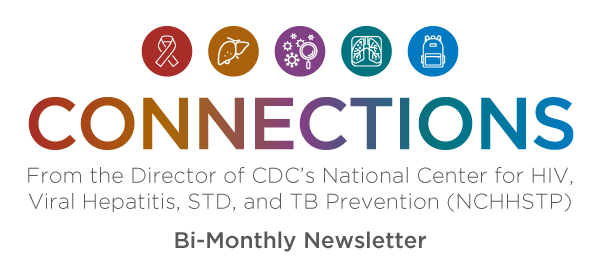
September – October 2022
From the Director - Jonathan Mermin, MD, MPH
Dear Colleagues:
How do we know what interventions work to improve health and well-being in schools? CDC uses evidence-based approaches to establish programs, such as What Works in Schools.
We all know about the struggles of students, teachers, and staff in our schools these past several years and how hard districts have worked to keep students connected and healthy. CDC’s newly released 2020 School Health Profiles report shows how schools implemented policies and practices to address issues and promote connectedness during the COVID-19 pandemic.
These data show the efforts schools made to keep students connected during this time and how much more is needed to support school connectedness for youth. For example:
- 81% of middle and high schools encouraged staff training on safe and supportive school environments;
- 70% of health teachers had recent classroom management training;
- 97% of middle and high schools prohibit harassment of LGBTQ students; and
- 80% identified safe spaces for LGBTQ youth.
Good policies and practices are especially critical for all students, including LGBTQ students, who are especially vulnerable. However, only 44% of middle and high schools have a gay-straight alliance and only 30% of middle and high schools report training staff on how to support LGBTQ students.
When schools put inclusive policies and practices in place, not only do LGBTQ students do better, but all students do better. Schools play a critical role in the lives of adolescents. When we work with schools to employ strategies that work, we can make long-lasting, positive change in this and future generations of young people.
While I serve as the Incident Manager for CDC’s monkeypox response beginning in October, Deron Burton, MD, JD, MPH (CAPT U.S. Public Health Service), will serve as Acting Director for NCHHSTP and taking over Connections while I’m deployed. I have full confidence in him and the other outstanding leadership in the Center while I and many others from NCHHSTP currently work to decrease incidence and health inequities occurring with monkeypox. You can read more in my recent dear college letter.
The 2022 monkeypox outbreak is associated with sexual and intimate contact and has disproportionately affected gay, bisexual, and other men who have sex with men (MSM). Articles recently published in CDC’s Morbidity and Mortality Weekly Report (MMWR) describe changes in sexual behaviors among MSM because of the outbreak and estimate how reductions in one-time sexual? partnerships could reduce infections and transmission. High prevalence of HIV and other sexually transmitted infections (STI) among persons with monkeypox is also reported. These findings underscore the importance of delivering tailored, nonstigmatizing messages to MSM, leveraging existing HIV and STI care and prevention systems, and ensuring equitable access to vaccines.
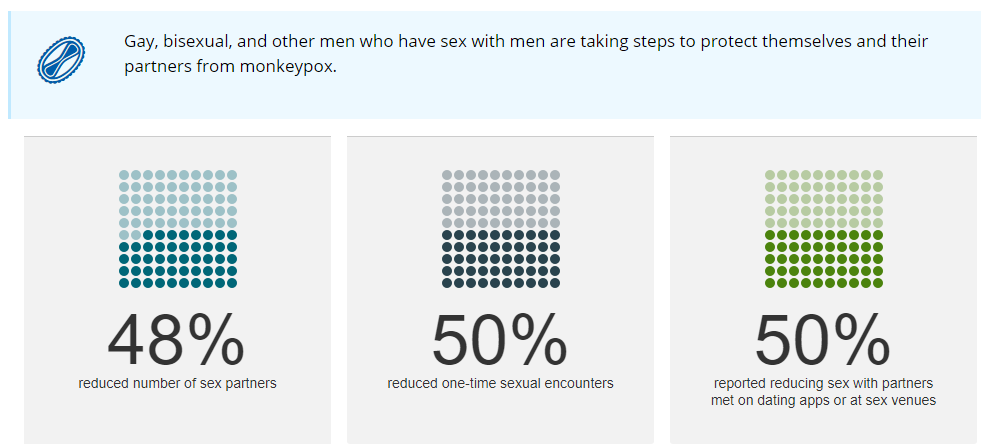
CDC, with the assistance of state and local health departments, healthcare facilities, the U.S. Food and Drug Administration, and the U.S. Department of Agriculture, recently published “Nationwide tuberculosis outbreak in the USA linked to a bone graft product: an outbreak report” in The Lancet Infectious Diseases. The article describes the response to a nationwide tuberculosis (TB) outbreak linked to a bone graft product containing live cells produced from a single deceased donor. CDC, federal partners, and organ and tissue donation organizations are working together to reduce the risk of TB transmission through tissue and organ transplantation in the future. Based on this investigation, the American Association of Tissue Banks issued new recommendations for preventing tissue-derived TB transmission.
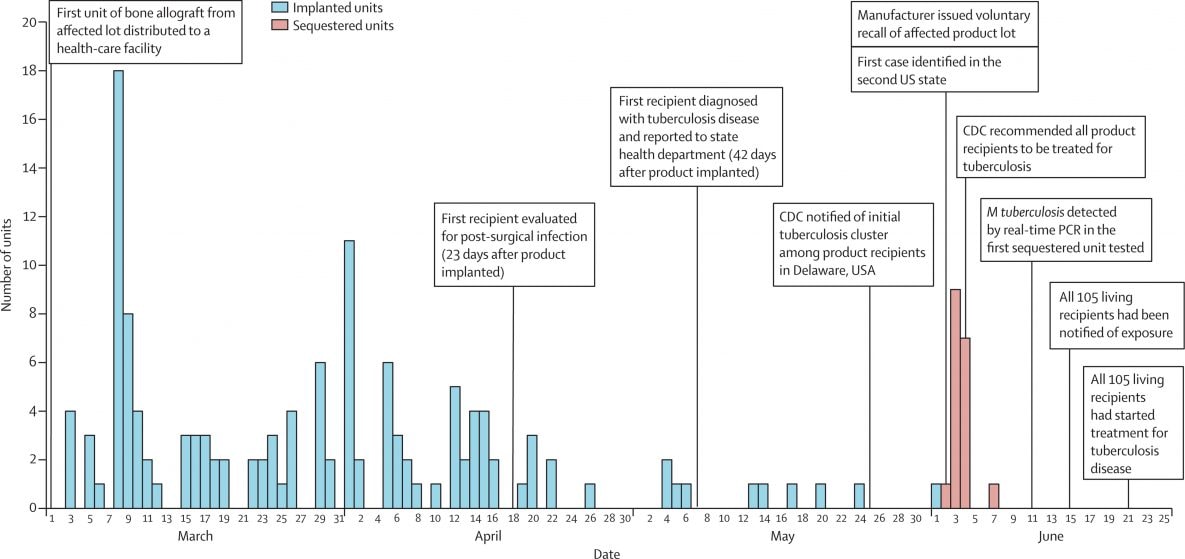
Summary Sources
- Curran KG, Eberly K, Russell OO, Snyder RE, Phillips EK, Tang EC, Peters PJ, Sanchez MA, Hsu L, Cohen SE, Sey EK, Yin S, Foo C, Still W, Mangla A, Saafir-Callaway B, Barrineau-Vejjajiva L, Meza C, Burkhardt E, Smith ME, Murphy PA, Kelly NK, Spencer H, Tabidze I, Pacilli M, Swain C, Bogucki K, DelBarba C, Rajulu DT, Daily A, Ricaldi J, Mena LA, Daskalakis D, Bachmann LH, Brooks JT, Oster AM; Monkeypox, HIV, and STI Team. HIV and sexually transmitted infections among persons with monkeypox—eight U.S. jurisdictions, May 17–July 22, 2022. MMWR Morb Mortal Wkly Rep 2022;71(36):1141–7.
- Delaney KP, Sanchez T, Hannah M, Edwards OW, Carpino T, Agnew-Brune C, Renfro K, Kachur R, Carnes N, DiNenno EA, Lansky A, Ethier K, Sullivan P, Baral S, Oster AM. Strategies adopted by gay, bisexual, and other men who have sex with men to prevent Monkeypox virus transmission—United States, August 2022. MMWR Morb Mortal Wkly Rep 2022;71(35):1126–30.
- O’Shea J, Filardo TD, Bamrah Morris S, Weiser J, Petersen B, Brooks JT. Interim guidance for prevention and treatment of monkeypox in persons with HIV infection—United States, August 2022. MMWR Morb Mortal Wkly Rep 2022;71(32):1023–8.
- Spicknall IH, Pollock ED, Clay PA, Oster AM, Charniga K, Masters N, Nakazawa YJ, Rainisch G, Gundlapalli AV, Gift TL. Modeling the impact of sexual networks in the transmission of Monkeypox virus among gay, bisexual, and other men who have sex with men—United States, 2022. MMWR Morb Mortal Wkly Rep 2022;71(35):1131–5.
Response Headlines
CDC streamlines COVID-19 guidance to help the public better protect themselves and understand risk. Read CDC’s media statement.
HHS Secretary Becerra issues 564 determination, paving way for emergency use authorization of monkeypox vaccines.
The White House announced a pilot program to increase Monkeypox vaccinations in jurisdictions who might benefit from expanded vaccination. Part of the strategy uses the estimated size of the population who are eligible for HIV pre-exposure prophylaxis (HIV PrEP). The data supporting this effort can be accessed at CDC’s AtlasPlus.
CDC creates better administrative procedures to support a syndemic approach to monkeypox and other STI and HIV activities.
Ad campaign promoting hepatitis C screening guidance
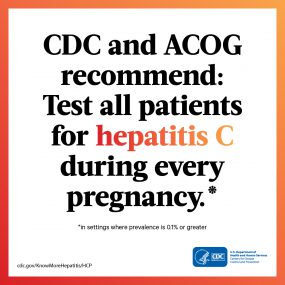
CDC released an ad campaign promoting hepatitis C screening guidance to primary care and prenatal care providers. Read more about how we are reaching out to our partners about screening guidance.
2020 Surveillance Report
CDC published Viral Hepatitis Surveillance Report— United States, 2020. This report includes surveillance and mortality data related to hepatitis A, hepatitis B, and hepatitis C, as well as outcome data from CDC’s Perinatal Hepatitis B Prevention Program. CDC also released the 2022 Viral Hepatitis National Progress Report, which provides an update on progress toward achieving established goals for the prevention of viral hepatitis transmission, disease, and associated mortality. These reports are published exclusively in digital format to improve accessibility for all audiences. Read more in my recent letter to our partners.
New Health Education Curriculum Analysis Tool (HECAT) webinar series
CDC released a new Health Education Curriculum Analysis Tool (HECAT) webinar series to help schools in selecting, developing, or revising health education curricula. The videos provide an overview and cover health topic modules from CDC’s HECAT Chapter 6: Alcohol and Other Drug Use Prevention, Mental and Emotional Health, Sexual Health, and Violence Prevention.
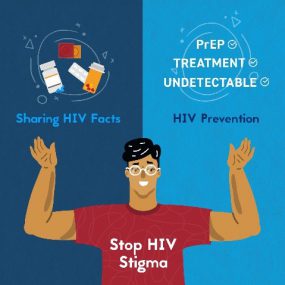
New Preventing HIV In Your Community Social Media Toolkit
The Let’s Stop HIV Together (Together) campaign rolled out a new social media toolkit – Preventing HIV In Your Community. The new multi-topic social media toolkit covers all HIV prevention options including testing, PrEP, treatment, and stigma to help partners promote and amplify HIV prevention in their communities. Contents are available in English and Spanish. This toolkit has ready-to-go messages for posting on Facebook, Instagram, and/or Twitter.
Sexually Transmitted Disease Surveillance: Preliminary 2021 Data
DSTDP released new preliminary 2021 STD surveillance data prior to the biannual 2022 STD Prevention Conference. The new preliminary 2021 data suggest STDs continued to increase during the second year of the COVID-19 pandemic with no signs of slowing. Nearly 2.5M cases of chlamydia, gonorrhea and syphilis were reported in the United States, reflecting a 4.4% increase since 2020. In 2021, health departments reported:
- Over 2,600 cases of congenital syphilis, a startling increase of nearly 185% since 2017,
- More than 171,000 cases of syphilis (all stages), an increase of 68% since 2017,
- Almost 700,000 cases of gonorrhea, an increase of 25% since 2017, and
- More than 1.6 million cases of chlamydia, a 3.1% increase from 2020 following a decrease in 2020 for the first time in seven years, which was likely due to reductions in chlamydia screening during the COVID-19 pandemic.
Preliminary 2021 data were provided through the National Notifiable Diseases Surveillance System (NNDSS) and sentinel surveillance systems between June 15 and July 7, 2022. STD surveillance data collected in 2021 will be provided to CDC through the Fall of 2022; however, it is already clear the pandemic continued to affect trends in diagnosed and reported STDs. A final 2021 STD Surveillance Report will be released in 2023.
STI Treatment Guideline application
CDC released the new STI Treatment Guide application on September 19. The application is free and publicly available.
National Prevention Information Network
NCHHSTP invests in the NPIN program to raise visibility, increase collaboration, and improve access to services for our Center’s topic areas. Subscribe to NPIN News to stay up-to-date and learn what NPIN can do for you. Also, be sure to check out the latest issue of NPIN News.
A recent CDC Vital Signs report found that too few people diagnosed with hepatitis C are being treated, even though hepatitis C is largely curable. According to CDC’s estimates, overall, less than 1 in 3 people with health insurance receive direct-acting antiviral treatment for hepatitis C within a year of diagnosis. Treatment is even lower among people who are Medicaid recipients, those living in states with Medicaid treatment restrictions, and among adults under the age of 40. Here are examples of media coverage around this data:
- Fewer than a third of insured Americans with hepatitis C receive timely treatment, CDC study shows – USA Today
- Fewer than 1 in 3 insured hepatitis C patients getting cure – Associated Press
- Few U.S. patients with hepatitis C get timely treatment, CDC says | Reuters
- La infección con la hepatitis C puede matar, pero menos de un tercio de los pacientes se tratan – HealthDay (Spanish)
- Less than a third of insured hepatitis C patients get timely treatment, study shows – CNN
To get the latest news and announcements from our Center, check out the NCHHSTP newsroom.
Dr. Jonathan Mermin
@DrMerminCDC
- October 15: National Latinx AIDS Awareness Day
- March 10: National Women and Girls HIV/AIDS Awareness Day
- March 20: National Native HIV/AIDS Awareness Day
- March 24: World TB Day
- April 10: National Youth HIV/AIDS Awareness Day
- April 18: National Transgender HIV Testing Day

Mary Cashin
Do you have feedback, story ideas, content you would like to see in the newsletter? Contact us
Get Connections. Your more interesting inbox awaits!
Subscribe now
Mary Cashin
Do you have feedback, story ideas, content you would like to see in the newsletter? Contact us
Get Connections in your inbox







